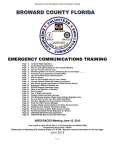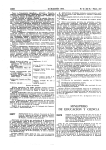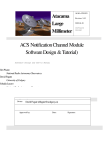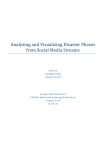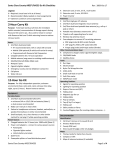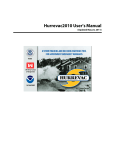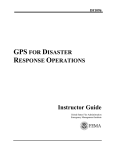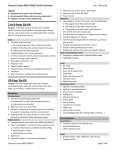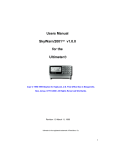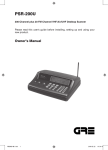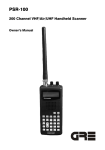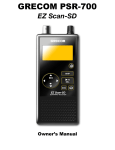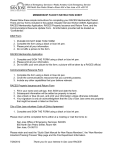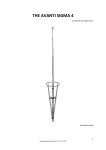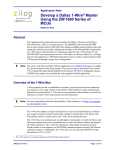Download Broward County ARES/RACES
Transcript
Broward County Emergency Communications Training EMERGENCY COMMUNICATIONS TRAINING Page 2. Page 2. Page 3. Page 4. Page 4. Page 5. Page 5. Page 6. Page 7. Page 7. Page 8. Page 11. Page 14. Page 16. Page 20. Page 22. Page 23. Page 24. Broward County ARES/RACES/SKYWARN Wish You a Happy New Year Do You Know What A Communications Emergency Is? From The Editor Information At Your Fingertips Communication Tips For Public Service Emergency Communication ARES/RACES Information Get Involved The 2014 Fort Lauderdale Winterfest A Huge Success FEMA Administrator on Amateur Radio use in an emergency I Just Got My Ham Radio License, Now What Do I Do? The National Weather Service “Working Together To Save Lives” Skywarn Training Coming What Is ARES/RACES ARRL’s Do’s and Don’ts for Public Service Communications Net Participation And Associated Emergency Operations RACES Application Map to ARES/RACES meeting Be sure and join us this coming Tuesday, January 20 th at 7:30 pm in the Oak Room at Broward Health Medical Center, 1600 South Andrews Ave., Fort Lauderdale for the Broward County ARES RACES meeting. We will have Jeff Stahl, K4BH give a presentation and hands-on demonstration on Anderson Power Poles. January 2015 1 Broward County Emergency Communications Training Broward County ARES / RACES / SKYWARN Wish You A Happy New Year. May this new year, all your dreams turn into reality and your efforts into great achievements. Let’s make a commitment toward Emergency Communications in Broward County to support the Broward County Emergency Management Division with Back-up communications when natural or a man-made disaster strikes disrupting our County’s communication. You will find an application in the back of this Newsletter. 73, Robin / N4HHP Editor ARES/RACES TRAINING Do you know what a Communications Emergency is? The easiest way to think about a communications emergency is to begin by using the definitions used in the Incident Command System (ICS). "We will define an incident as any planned or unplanned occurrence or event, regardless of cause, which requires action by emergency service personnel to prevent or minimize loss of life or damage to property and/or natural resources." We can see that during a large scale event it would be possible to have enough information (traffic) flow that the emergency service communications could become overloaded to a level that it would fail to function as required by the incident. What defines a communications emergency? When normal communications processes are inadequate to handle the information flow required to service an incident as defined in the ICS. What role does Amateur Radio serve? Our primary role is to support the emergency management community (responders, relief and recovery agencies) with communications during times of emergency and disaster when normal communications are overloaded or non-existent. 2 Broward County Emergency Communications Training From The Editor Amateurs often ask me “Why do you (I) write this Newsletter”? I have always felt that I can contribute to the ham community by belonging to a club, becoming and Extra Class Operator, from chairing many committees, becoming an officer from the Administrative Officer position to being Club President (which I was for 12 years), being a Volunteer Examiner since 1984, to becoming a Volunteer Examiner Coordinator, RACES Officer since 1985 and the Skywarn Coordinator since 1990. I also am the Chairman for the Fort Lauderdale Winterfest Boat Parade since 1990 and the list goes on and on. I have written a club newsletter for over 15 plus years now and the Broward County ARES/RACES/SKYWARN Training Newsletter for over a year now. The purpose for me writing this Newsletter is not geared to the “old timer” even though they may learn a thing or two, but to the new ham that just got their ticket. The Broward County ARES/RACES/SKYWARN Newsletter is a monthly, free, independent Amateur Radio information periodical. Since its creation, this Newsletter has grown to where it currently enjoys a wide distribution in Florida and other states by email. It is sent to amateur radio operators, clubs, public service officials, and other interested parties. This Newsletter attempts to provide balanced coverage of ARES/RACES, Skywarn and other information that caters to both the new and seasoned ham. It's a big hobby, and there's a lot of territory that can be covered in a Newsletter. Attempts have been made as much as possible to keep interested parties informed. Permission is granted to subscribers to reprint all or portions of this newsletter for distribution to others, and materials herein may be used as long as this newsletter is referenced as the source, or sources noted within the newsletter are credited. Join the Fun! Share an article you found (sources properly credited, please), or, better yet, one YOU wrote! We'll publish it in the Newsletter! Also, please share your comments, concerns, suggestions, or questions. All are welcome. Articles however, are subject to editing as necessary. Send your submissions to: [email protected]. All items must be camera ready. The Deadline for submitting material for the BARC Newsletter is the 1st of the month. But most of all, I enjoy writing them and hope you enjoy reading them too. If you would like to contribute an amateur related article, a weather training article, video or even a ham related joke or two, I would love to hear from you. 73, Robin / N4HHP Editor Sincerely, Robin Terrill N4HHP Broward County RACES Officer Broward County Skywarn Coordinator 954 249-5343 [email protected] 3 Broward County Emergency Communications Training Information at Your Fingertips By Carol Sjursen, KJ4AWB Have you ever needed information or had a question about ham radio emergency communications and didn’t know where to turn? Have you ever wondered if there was a website that would have all of the local information gathered in one place? Do you use Social Media to find information? In doing a website for one of the local clubs, Ty Sarna, N1TY had an idea to compile all of the information he could gather on emergency communications in one place for the benefit of all of the hams in Broward County. With input from a number of hams, Ty developed a professional looking website for the Broward County ARES RACES organization. Anything you want to know about emergency communications can be found on this website from training materials to standardized incident forms. If you haven’t been to the website, make sure you visit the site and check it out. Ty has spent numerous hours developing the site and uploading useful information. This website is a work in progress, and new things are being added on a regular basis. Visit the Broward County ARES RACES website at www.BrowardARESRACES.org. Ty is always looking for ideas and suggestions to make the website better. You can reach Ty at [email protected]. Communication Tips For Public Service Source From The ARRL Here is a useful set of tips from ARES/RACES that are useful in any Ham Radio communication events: You are your own safety officer. The very first thing on your mind should be, is it safe? Am I going to irradiate anyone with RF? Have I created an electrical hazard? Could anyone trip over my feed line or get poked in the eye by my antenna? The safety of your station is your responsibility. Make sure that it won’t harm you or others. Are you following procedure? Operating procedures are developed from examining what went wrong before. Familiarize yourself with the procedures and practice them in exercises. Arriving at communications event or a county assignment and winging it will only cause problems. Check your transceiver for overheating. Always have a backup plan if your primary communication fail. You are ready to participate. Caution is good, but don’t let it prevent you from participating and volunteering. Everyone makes mistakes and everyone survives them. Most hams will be sympathetic and supportive of your efforts. Don’t avoid the exercises. It’s a mistake to ignore an exercise because you think you are already familiar with what it is about. There are always surprises, new elements, and things that you’ve forgotten. The ARES communication that we provide each year include ZMotion, American Diabetes, the Fort Lauderdale Winterfest Boat Parade along with other public service events. RACES covers shelters, special care facilities, hospitals, EOC’s and other agencies like the Broward County Emergency Operations Center during man made or natural disasters. Keep learning. Everything is dynamic, including emergency communications. Never sit back and feel that you’ve learned everything you’ll need to know. Be able to power your radio. Change frequencies at a moment’s notice. Power connections are not generic. ARES/RACES groups around the country use Anderson Power Poles as the standard power connector. Mark your equipment at any communication event. Mark every piece of your equipment with at least your name and call sign. You’ll want property you left behind to find its way back to you. Have a set of headphones. A headset should be a vital part your equipment. You can’t communicate if you can’t hear. Can you think of anything else I have left off of this list? Please attend our ARES/RACES meeting and share what you think a Ham Radio operator needs when communicating for ARES and or RACES. For the January ARES/RACES meeting, there will be an Anderson Power Pole demonstration. Please plan on attending. 4 Broward County Emergency Communications Training Broward County ARES / RACES Organization Are you interested in helping our community? All ARES/RACES members and any Amateur interested in emergency Communications are encouraged to participate. For ARES/RACES information and announcements go to: https://www.facebook.com/BrowardARESRACES Broward County ARES/RACES Meeting 3rd Tuesday of the month, at 7:30 P.M. Meeting in the Oak Room. Broward Health (The old Broward General Medical Center) 1600 South Andrews Avenue, Fort Lauderdale, FL 33316 Meeting is held In The Oak Room Do You Know What Broward County ARES & RACES IS? No dues of membership fees Both ARES/RACES is an organization not a club! Learn emergency communications skills Learn about different modes of communications Learn about one another Learn about Skywarn and storm spotter skills Participate in drills, public service events, field day and much more We provide back-up communications for served agencies in our community. These served agencies include but are not limited to the Broward County Emergency Management Division, American Red Cross, National Weather Service, shelters, special care facilities, hospitals and special events that go on in our County. We also provide emergency communication during drills, table top exercises and public events such as the annual American Diabetes Association Tour de Cure’s bike rides and the annual Fort Lauderdale Winterfest Boat Parade to name a few. 5 Broward County Emergency Communications Training When hams engage in public service as mandated by the FCC Rules, the benefits go well beyond just following the rules. We can enjoy our hobby – have fun! We protect the health and safety of event participants. We support worthy charities. We learn to work within an organized effort. We experience the technical aspects of operating under adverse conditions. We also can practice for communicating under emergency conditions. We can demonstrate these qualities to the communities we serve and thus promote our service for their acceptance. Throughout the year, ARES coordinates numerous public service events. Most of these are also suitable for hams that are new to our hobby as well as experienced hams to participate in. If you’re new to the hobby, I will pair you up with a seasoned ham so you can learn what public service communications is all about. For 2015, we have already been tasked with several events which will be announced as they are confirmed. If you would like to join Broward County ARES & RACES, please visit us at a meeting on the third Tuesday of each month (except December). Our meeting place is at Broward Health in the Oak Room located at 1600 South Andrews Avenue. See the map on the last page of this newsletter. Meanwhile, please join us on our ARES/RACES page. https://www.facebook.com/BrowardARESRACES For more information please contact: Carol Sjursen / KJ4AWB Broward County ARES Emergency Coordinator [email protected] Robin Terrill / N4HHP Broward County RACES Officer [email protected] Get Involved: If you are not involved in ham radio and are interested in communications and public service, we want to talk with you! We are always looking for interested individuals who want to uniquely serve their communities. All it takes is to get an FCC issued ham radio license is the desire to learn. If you are in emergency management, state or federal government, law enforcement, fire service, emergency medical service, health service, or a private disaster support agency and are not engaged with your local ARES/RACES group, contact Robin Terrill, N4HHP or Carol Sjursen, KJ4AWB. Enjoy serving your community. Learn from your experiences, generate ideas to take back to your organizations and then share those ideas with us so we can share them with others. REMEMBER, we provide communications when no one else can! 6 Broward County Emergency Communications Training THE FORT LAUDERDALE ANNUAL 2014 WINTERFEST BOAT PARADE A HUGE SUCCESS! https://www.youtube.com/watch?v=IFW8rg0Ucfs Parade supporters explain (above) why this event is the Top 20th Parade in the World and the Greatest Show on H2O! Amateur radio Communications are the “eyes and ears” to the Winterfest staff, coordinators and Television Station WSVN. This Parade has over 1,000,000 Live Viewers and over 8,000,000 In TV Land. This Parade is just over 12 miles long with 7 bridges from the New River, east to the Intercostal water way north. The amateur radio operator that provided communications for the 2014 Fort Lauderdale Annual Winterfest Boat Parade were AK4DM, W2SNN, KE4OV, KK4KDP, KE4IEW, KA4DMV, KI4JRT, N4OMB, K1RFL, KI4QEX, WA2KF, W4SOG, KD4DTF, KJ4EGN, KJ4FSI, KJ4FSJ, W4PSJ, KJ4LOW, W2RAU, KM4DQQ, KM4DQM, KM4SST, N4KVE, K4FLL, N4BGW, W4NTR, N1TY, AJ4ME, N4HHP, KJ4AWB, KB4FR, KS4VT, N4JQP, KK4OXM, W4PSJ, N4MEO, N4JRW, WB4RFC and KC4KM To all of the amateurs that provided communications for this event, thank you for a job well done. Looking for your communication support in 2015. Robin Terrill, N4HHP, Fort Lauderdale Winterfest Boat Parade Communications Chairman FEMA Administrator on Amateur Radio use in an emergency What FEMA thinks about Amateur Radio. Published on Jul 7, 2012 This video was filmed by the FCC and is in the Public Domain. At an FCC conference in May 2011, FEMA Administrator Craig Fugate mentioned that “When Everything Else Fails. Amateur Radio often times is our last line of defense.” He said that we often rely on cell phones and public safety communication for their resilience, but we must remember that they fail–“They do, they have, they will!” Mr. Fugate went on to recommend that “A strong amateur radio community,” “be plugged into” emergency communications plans. He emphasized that amateur radio should be included in emergency planning, because “When you need amateur radio, you really need them.” In closing he included amateur radio communications as part of a broad mission which has one objective to meet the needs of survivors of a disaster. http://www.pinterest.com/pin/401242648026147523/ 7 Broward County Emergency Communications Training Written by “Michael Martens, KB9VBR. www.jpole-antenna.com” Reproduced With Written Permission I just got my ham radio license, now what do I do? Your new callsign has appeared in the FCC database and your license came in the mail. Congratulations, you are now officially a Ham Radio Operator. What’s next? I know those weeks when I first was licensed were pretty exciting times. I couldn’t wait to buy that radio, get on the air, and make lots of contacts. I thought I was pretty hot stuff. It didn’t take long for me to realize how little I actually knew. Last week I posed the question on our Facebook page: “what is the one thing you wish they told you when you were studying for your license”, and received a flood of comments that brought back memories of the challenges I had just starting out. So here are the three things I wish I knew when I started out in the grand adventure that is amateur radio. Join a club, find an elmer “Amateur radio is a hobby were you learn by doing, and the best and fastest route to competency is by getting involved with a club.” Amateur radio is a hobby were you learn by doing, and the best and fastest route to competency is by getting involved with a club. I know many people have love/hate relationships with clubs, some are filled with politics and it sometimes can be difficult to break into a group of people that have been doing the same thing for years and years. When I was starting out, the first thing I did was attend a local club meeting. I didn’t know anyone and the politics were over my head, but I had a radio and a willingness to use it. So I signed up to help provide communications for a trail race. The race was poorly organized and even the experienced hams had no idea what we were doing, but participating was enough to create the bond and become welcome into the group. Clubs are also your gateway to finding an elmer. Elmers are nothing more than mentors: a person that will answer your questions, get you going in the right direction, and pique your curiosity. Having someone that will give you advice and answer your questions, no matter how seemingly stupid, is invaluable. Why struggle in programming that radio alone when you can struggle together with someone that has done it before. Finding that elmer isn’t always an easy process, but here’s some tips on how to sift through the amateur radio community to find someone that is willing and able to help. 8 Broward County Emergency Communications Training Listen on the local repeater for that person that has a warm, friendly attitude. There’s all sorts of people that populate the local repeaters, but a potential elmer are those that are patient, welcoming, and willing. If your ‘BS meter’ rises when a person is talking, then they are most likely not the best elmer material. Go to a club meeting and look for the hams that kind of hang around chatting. Those are the ones that are more likely to help you out. Who were the three people that signed your VE forms? If they’re putting in the time to run a testing session, most likely they will offer advice to a new ham. Find someone that has been recognized for their achievements. Peer recognition is probably the best way to find true ‘elmer material. Buy that first radio There are an overwhelming number of choices in radios. Handheld, mobile, or all-mode all band, how do you pick one. This could be a topic for later discussion, but most new hams starting out with a Technician license often pick an inexpensive dual band handheld radio. The big three manufacturers have great entry portables in the $100-$200 price range, but many new hams opt to purchase one of the Chinese portables that are flooding the market for as little as $30. These are good starter radios, but their non-intuitive interface and hit and miss quality may not make them the best choice for someone starting out. Here’s why: there is nothing more frustrating for someone starting out than to be unable to make a contact on the repeater due to a difficult to program radio. Here’s where elmers fit into situation. Get some personal recommendations on radios by talking to local club members, or ham radio shop if one is in your community. If you’re shopping online, search and download the user manual for a few models to see if operation makes sense to you. Programming software is becoming available that makes even the Chinese radios more user friendly. If you already have the radio, bring it and a copy of the manual to a club meeting, and you’ll soon be on the air. Make that first contact You’ve got your license, you have the radio, now it’s time to make the first contact. What do you say? If it’s the local repeater, the easiest way to start out is to press the transmit button and say “[callsign] listening.” I like to monitor while I’m in the car, so I’ll announce that I am mobile with a “[callsign] mobile.” Sometimes you’ll get a response, sometimes not. It’s a lot like fishing. Listen before transmitting. Listen a lot. If you are on a local repeater, have it on in the background and monitor. You’ll soon get the feeling of who’s on the air and when the activity periods are. Morning 9 Broward County Emergency Communications Training and evening drive time is a great time to monitor, and in the evening, especially before or after a local club net. If the repeater has a net, participate in it. You’ll soon get the hang of talking on the air. What do we talk about? Great question, how about the weather, where you live, that you are just starting out in ham radio, other interests, family, work, etc. Dale Carnegie teaches a process called the Conversation Stack that is useful is keeping a conversation going when you meet someone new. If you have trouble talking to people, I recommend the Conversation Stack visual mnemonic. It really works. Finally, keep the transmissions brief- you don’t have to be long winded, allow an appropriate amount of time (1-3 seconds) in case another stations wishes to jump in, and wait approximately one second after you key the mic before you start speaking. This allows the repeater system enough time to activate without cutting off the start of your transmission. There is always something “more” I can’t say it any better than Facebook user Anne D: That there would always be something “more”. Got my Tech ticket in May 2011, caught the HF bug at Field Day, successfully passed the General test in October of that year, bought an HF rig, put up a wire, joined a DX club, joined a YL club, check in regularly with 3 nets, got my Amateur Extra and VE credentials earlier this year – would like to learn CW and try digital modes, learn to solder, build my own antennas, try QRP – there’s always something new that catches my interest – and always more to learn – best hobby EVER! Don’t let your lack of knowledge be a limitation. Ask questions, explore, and get involved. Amateur Radio is a great activity, and one that is always on the forefront of technology. Hams truly are a sharing bunch. We were all new once, and if we seem a little crusty, please give us a gentle reminder of what it’s like to be just starting out. 10 Broward County Emergency Communications Training Many ARES® and RACES members participate in SKYWARN® activities. To be an effective ARES/RACES member performing SKYWARN activities a good weather go kit is a must. It is also required that you participate in the NWS training provided by the NWS located in Miami-Dade Florida. The NWS provides free Classes in Skywarn training though out the State of Florida : Broward County Skywarn training – The classes taught by the NWS here is a combined basic and advanced class which starts at 10:00 AM to around 2:30 PM. The Miami-Dade NWS office is responsible for Miami-Dade, Broward, Palm Beach, Mainland Monroe, Collier, Hendry and Glades counties, as well as Lake Okeechobee Skywarn classes. Information And Contact Concerning The National Weather Service: (IMPORTANT – if you have taken the Skywarn Class, the toll free number is on the back of the card. Please do not distribute this number as this is for official SKYWARN and Emergency Management use ONLY!) Broward County Skywarn Coordinator: Robin Terrill N4HHP…..….954 249-5343 [email protected] Severe Weather Number for general public use................................305 229-4522 Fax number......................................................…………………………..305-229-4553 E-mail.............................................................................Meteorologist [email protected] E-mail............................................................................ Meteorologist [email protected] NWS website in Miami Dade County................................................... http://www.srh.noaa.gov/mfl Storm Prediction Center...................................................................... www.spc.noaa.gov Heavy Precipitation Center (NCEP)......................................................www.hpc.ncep.noaa.gov NWS/NOAA Online Weather School.....................................................www.srh.noaa.gov/Jetstream Community Collaborative Rain, Hail and Snow Network………….…www.cocorahs.org Broward County Emergency Operating Center………………………..954 831-3900 The online .pdf of the spotter field guide at: http://www.nws.noaa.gov/os/brochures/SGJune6-11.pdf The AHPS River Forecast link is:…………….http://water.weather.gov/ahps2/index.php?wfo=mfl The AHPS River Forecast link is:…………… http://water.weather.gov/ahps2/index.php?wfo=mfl Amateur Radio Network To The NWS In Miami-Dade County Broward County Amateur Radio Frequency to the NWS .……………...Main: 146.910 MHz -6 PL100.9 Hz …………………………………………………….......................................Back-up: 146.790 MHz -6 PL 88.5 Hz To send a video or picture, spotters can call the NWS by Telephone, and any of the forecasters can give you an email address to send media to. Please keep this information handy for quick reference When calling the NWS, identify yourself with your Skywarn number to identify yourself 11 Broward County Emergency Communications Training Understand Reporting Criteria Of The National Weather Service IMPORTANT WEATHER TO REPORT: When you report, please give your SKYWARN number, your location (including your county), and the time of the observation. Try to report as soon as possible after observing the event and, remember to be careful! Please concentrate on the following phenomena: WIND SPEEDS: Report wind speeds greater than 40 mph RAINFALL: Report when you receive one inch (and then at least every inch thereafter) FUNNEL CLOUD: a “rotating” appendage descending from the base of a cumulonimbus cloud, but not touching the ground. If possible, always look at the area beneath the funnel cloud for flying debris. If flying debris is observed, it is a tornado. TORNADO: Violently rotating column of air descending from a cumulonimbus cloud and touching the ground. Look for flying debris. If possible, report any injuries or fatalities HAIL: Report any size hail. Specify the diameter based on the size of coins. HAIL Pea Plain M&M Penny Nickel Quarter Half Dollar Scale (0.25 in) (0.50 in) (0.75 in) (0.88 in) (1.00 in) (1.25 in) Golf ball Baseball Softball (1.75 in) (2.75 in) (4.00 in) FLOODING Report any flooding you observe, the location and depth. DAMAGE: Report all storm-related damage (large branches, fallen trees, structural damage, flood damage, etc.) Even if it is several days after the event. FUJITA SCALE (Enhanced F scale – February 2007) F0 = Gale Tornado [winds 40 to 72 mph] EF0 65-85 mph F1 = Moderate Tornado [winds 73 to 112 mph] EF1 86-110 mph F2 = Significant Tornado [winds 113 to 157 mph] EF2 111-135 mph F3 = Severe Tornado [winds 158 to 206 mph] EF3 136-165 mph F4 = Devastating Tornado [winds 207 to 260 mph] EF4 166-200 mph F5 = (Rare) Incredible Tornado [winds 261 to 318 mph] EF5 >200 mph ESTIMATED WIND SCALE 25-31 MPH...............Large branches in motion; whistling in telephone wires 32-38 MPH...............Entire trees in motion; slight difficulty walking against wind 39-54 MPH...............Twigs break off trees; wind generally impedes progress 55-72 MPH...............Damage to chimneys and TV antenna; large limbs/branches down 73-112 MPH.............Roof surfaces damaged; windows broken; light mobile homes moved or overturned moving vehicles pushed off road 113-157 MPH...........Roofs torn off; weak buildings and mobile homes destroyed 158 MPH..................Severe damage; cars lifted completely off ground DEFINITIONS: Severe Thunderstorm: A thunderstorm which produces hail to 1 inch in diameter or larger and/or wind gusts to 58 mph (50 kts) or greater. Watch Conditions are favorable for the weather event in or near the watch area Warning. The weather event is imminent or occurring in the warned area Advisory. The weather event will be an inconvenience. However, if caution is not exercised, it could become life-threatening. Flash Flood: A flood caused by heavy rainfall in a short period of time, generally less than 6 hrs Flood Inundation caused by heavy rain which generally takes greater than 6 hrs to occur Tornado: A violently rotating column of air which extends from a thunderstorm and it is in contact with the ground. 12 Broward County Emergency Communications Training Funnel Cloud: A rotating, funnel-shaped cloud extending from the base of a thunderstorm and is not in contact with the ground Downburst: A strong downdraft with an outrush of damaging wind on or near the ground Macroburst: A swath of damaging wind more than 2/5 miles wide Microburst: A swath of damaging wind 2.5 miles wide or less What you should report: Rain—Over 1 inch an hour recorded over a 10 minute period of time. Wind—Gusts higher than 58mph Hail— Specify the diameter based on the size of coins. HAIL Pea Plain M&M Penny Nickel Quarter Half Dollar Scale (0.25 in) (0.50 in) (0.75 in) (0.88 in) (1.00 in) (1.25 in) Golf ball Baseball Softball (1.75 in) (2.75 in) (4.00 in) Flooding—any flooding that does not normally occur. Be careful with this, when driving around you may find an intersection under 2 feet of water and unknown to you this happens during most rain storm due to a drainage issue. Lowering and cloud rotation—Persistent rotation of the cloud base and lowing can lead to the development of a funnel cloud and should be reported. Funnel Development—when reporting a Funnel be sure that what you are seeing is not scud that is floating around under the cloud base. Tornado Formation—a funnel become a tornado only after the vortex reaches the ground. This is usually initially indication by the creation of rotating debris or dust field under the funnel. Remember there can be clear air between the funnel and the debris field on the ground. Injury or Damage—any injuries to live stock or people as well as storm related damage should be reported. Remember, you are working for the United States Department of Commerce as an unpaid volunteer under the auspices of The National Weather Service Forecast Office in Miami-Dade Florida. Where ever you go is your own choice. Be careful and ALWAYS consider your safety and the safety of others. Being a weather spotter does NOT grant you the right to break any laws or enter private property without permission being granted. Above all, remember safety is a priority. 13 Broward County Emergency Communications Training What is SKYWARN®? The effects of severe weather are felt every year by many Americans. To obtain critical weather information, NOAA’s National Weather Service (NWS), part of the U.S. Department of Commerce, established SKYWARN® with partner organizations. SKYWARN® is a volunteer program with nearly 290,000 trained severe weather spotters. These volunteers help keep their local communities safe by providing timely and accurate reports of severe weather to the National Weather Service. Although SKYWARN® spotters provide essential information for all types of weather hazards, the main responsibility of a SKYWARN® spotter is to identify and describe severe local storms. In the average year, 10,000 severe thunderstorms, 5,000 floods and more than 1,000 tornadoes occur across the United States. These events threatened lives and property. Since the program started in the 1970s, the information provided by SKYWARN® spotters, coupled with Doppler radar technology, improved satellite and other data has enabled NWS to issue more timely and accurate warnings for tornadoes, severe thunderstorms and flash floods. SKYWARN® storm spotters are part of the ranks of citizens who form the Nation’s first line of defense against severe weather. There can be no finer reward than to know that their efforts have given communities the precious gift of time–seconds and minutes that can help save lives. What will I learn as a Skywarn Storm Spotter? Training covers: Basics of thunderstorm development Fundamentals of storm structure identifying potential severe weather features Information to report How to report information Basic severe weather safety Where can I get more information about becoming a Skywarn Storm Spotter? Go to: http://www.stormready.noaa.gov/contact.htm and click on your state. When your state comes up, click on the name of your Weather Forecast Office (WFO). Once at your local WFO home page, in the blue bar on the left, look for the SKYWARN link to find a schedule of classes and other local information. This four hour BASIC/Advanced SKYWARN Storm Spotters training class will be on Tuesday, Saturday February 21st. 2015 Note that you must preregister for this class, and there is no charge for this class or materials. Please bring a picture ID to gain admittance to this class 14 Broward County Emergency Communications Training The class is intended for those interested in becoming a Skywarn Storm Spotter. Interested persons must be at least 14 years old, accompanied by an adult and preregister by Monday February 16 th, by emailing Robin Terrill, the Broward County Skywarn Coordinator. Email: [email protected]. When registering for the class, please include your name, home address, cell phone number and your callsign if you are a ham so I can preregister you prior to the class. You can bring a bag lunch and drink with you and you can even eat it during the class or during numerous 15 minute breaks. Training is required in order to become a recognized Storm Spotter. SKYWARN classes are ideal for amateur radio operators, CERT members. Red Cross volunteers, firefighters, nurses, doctors, students or anyone who is interested and wants to serve. Classes will be taught by a meteorologist with the National Weather Service from Miami-Dade County. SKYWARN Storm Spotters is a nationwide network of volunteers who report observations of significant weather and damage resulting from severe weather to the National Weather Service. The National Weather Service then sends alerts to the public via television, radio, marine and NOAA weather radios, public safety agencies and other information sources that severe weather is approaching or has been sighted. The address and directions to the class: 201 NW 84th Avenue Plantation Fl. Broward County Emergency Management Division 15 Broward County Emergency Communications Training What is ARES and RACES? Resources from the FEMA, ARRL, Broward County Emergency Management and the RED CROSS Our Mission Statement: A primary responsibility of the Amateur Radio Service, as established by Part 97 of the Federal Communications Commission’s Regulations, is the performance of public service communications for the general public, particularly in times of emergency when normal communications are overloaded or nonexistent. Broward County ARES / RACES members, will equip themselves and train to provide communications as a direct service to the general public through government and other resource agencies relief agencies of Broward County when requested by those agencies. Example; Red Cross, Special Care Facilities, hospitals and numerous other agencies when the need arises. What Exactly Does This Mean? Provide health and safety communication services for emergencies and disasters in Broward County and in other areas when requested Provide health, safety and coordination services for community events Maintain disaster and emergency readiness by conducting regular simulation drills and participating in County run disaster simulations and table top exercises Educate and train new amateur radio operators and to maintain a well-tuned ARES/RACES team Conduct FCC testing for new licenses and those wishing to upgrade Create a positive, supportive environment for our members that promotes camaraderie and fellowship. The ARRL definition (4.1) of what is RACES? RACES, administered by local, county and state emergency management agencies, and supported by the Federal Emergency Management Agency (FEMA) of the United States government. It is a part of the Amateur Radio Service that provides radio communications for civil-preparedness purposes only, during periods of local, regional or national civil emergencies. These emergencies are not limited to war-related activities, but can include natural disasters such as fires, floods and earthquakes. As defined in the rules, RACES is a radio communication service, conducted by volunteer licensed amateurs, designed to provide emergency communications to local or state civil-preparedness agencies. It is important to note that RACES operation is authorized by emergency management officials only, and this operation is strictly limited to official civilpreparedness activity in the event of an emergency-communications situation. The ARRL definition (4.2) Operating Procedure Amateurs operating in a local RACES organization must be officially enrolled in the local civil-preparedness agency having jurisdiction. RACES operation is conducted by amateurs using their own primary station licenses and by existing RACES stations. While RACES was originally based on potential use for wartime, it has evolved over the years, as has the meaning of civil defense (which is also called civil preparedness), to encompass all types of emergencies. While operating in a RACES capacity, RACES stations and amateurs registered in the local RACES organization may not communicate with amateurs not operating in a RACES capacity. Such restrictions do not apply when such stations are operating in a non-RACES–such as ARES–amateur capacity. Only civilpreparedness communications can be transmitted. 16 Broward County Emergency Communications Training ARRL definition (4.3) ARES and RACES Although RACES and ARES are separate entities, the ARRL advocates dual membership and cooperative efforts between both groups whenever possible for an ARES group whose members are all enrolled in and certified by RACES to operate in an emergency with great flexibility. Using the same operators and the same frequencies, an ARES group also enrolled as RACES can “switch hats” from ARES to RACES and RACES to ARES to meet the requirements of the situation as it develops. For example, during a “non-declared emergency,” ARES can operate under ARES, but when an emergency or disaster is officially declared by a state or federal authority, the operation can become RACES with no change in personnel or frequencies. This situation is still not well understood and accepted throughout the United States; both ARES and RACES still exist, separately, in many areas. League officials will have to determine the situation in their own area. Where there is currently no RACES, it would be a simple matter for an ARES group to enroll in that capacity, after a presentation to the civil-preparedness authorities. In cases where both ARES and RACES exist, it is possible to join both or to be involved in either. As time progresses, the goal would be the merger into one strong organization, with coordination between ARES and RACES officials using the same groups of amateurs. In some sections of the U.S. today, the ARES structure has also been accepted as the RACES structure. Broward County ARES/RACES provides emergency Communications support. When the cell towers are down, or overloaded, when the telephone lines are down and the power is out, Amateur Radio operators can communicate with other operators anywhere in the world. All members of ARES / RACES are volunteers with various levels of Amateur Radio licenses. We also volunteer Amateur Radio equipment when we are called to serve. A good source of information on what the amateur could do is narrated by the late Walter Cronkite, entitled, “Amateur Radio Emergency Service Today” – YouTube Video ARES/RACES members are urged to take the FEMA Independent Courses (IS) Online. You will find an complete listing here at: http://training.fema.gov/IS/crslist.asp The IS-100a , IS-700a, IS-200b and IS800b course completions are currently required by the State of Florida. Upon completion of this courses, this would qualify you to work any County or State declared Emergency incidents. The descriptions of these courses are: IS-100a Introduction to Incident Command System http://training.fema.gov/EMIWeb/IS/is100FWA.asp IS 200b ICS for Single Resources and Initial Action Incidents - http://training.fema.gov/EMIWeb/IS/is200b.asp IS 700a National Incident Management System (NIMS) An Introduction. - http://training.fema.gov/EMIWeb/IS/is700a.asp IS 800b for National Response Framework, An Introduction - http://training.fema.gov/EMIWeb/IS/IS800b.asp ***A course number that has a letter after the number is a newer version of the course*** To signup, go to this web page: , http://training.fema.gov/IS/ If you do not complete any course in one sitting, you will have to start all over again as you cannot save it. At the end you will fill out personal info for your certificate and you may or may not get a certificate in your email, or it may come by mail in a week. If you complete these, and other IS courses, please forward the emailed completion certificates to Robin Terrill, [email protected] and I will forward these certificates to the Broward County Emergency Management Division. 17 Broward County Emergency Communications Training Please keep all original cards/certificates from these trainings in the event you need to prove you have taken them. Training is also given by Red Cross (contact the Broward Red Cross office (954 797-3800) for classes): First Aid CPR AED Blood Borne Pathogens – (optional) Disaster Services: An Overview – (optional) Shelter Operations and Simulation – (optional) Disaster Assessment – (optional) Mass Care – (optional) HOW BROWARD COUNTY ARES and RACES WORK When There Is a Callout? Certainly Broward County ARES, RACES and SKYWARN Amateur Radio Operators should never attempt anything above their level of training. Unauthorized Search and Rescue is a good way to get shot. Medical treatment above your level of training can get you sued, issuing request for supplies or equipment must be authorized by responsible officials, in writing and preferably signed, to protect us from possible financial responsibility for unauthorized requests. Amateur Radio Operators could be self-alerted by ham radio, news media, TV, or Radio reports. Such preparatory measures such as charging batteries, loading a go bag in your vehicle, all necessary equipment, supplies and personal comfort items should be located, placed in the vehicle or where they can be quickly obtained. The cardinal rule of Emergency Responses is listen, listen, and then listen some more. How many times have you heard a station occupy an Emergency Repeater with idle chit chat knowing full well that Emergency Response Stations are monitoring for potential future developments of an Emergency Situation for possible activation. The inconsiderate ham is one that gets on the frequency and ask for a radio check. I personally think that is rude and unbecoming an amateur. Especially when that person had no intention of volunteering in the first place. The time to check that your equipment is working is not during a declared emergency. If this is you, I hope that you will learn that this is not acceptable by all standards of emergency communications. When you are aware of a possible disaster by ham radio, AM/FM radio, TV, or by telephone, the first thing you should do is monitor your radio. The second thing that you should do is to prepare yourself and your belongings for possible deployment to your assigned position. If the Net Control Station ask if there are other hams that would volunteer for an assignment, if you’re not willing to take on an assignment, then stay off the airways. We do not take check-ins and there are no prizes if you do. Do not just show up at a shelter, EOC, Red Cross site, disaster site, staging area, unless requested to do so by the Emergency Coordinator or RACES Officer. These rules are not made lightly and these rules are what professional Emergency Managers expect of professional Emergency Responders. Years of practical experience has developed these rules of engagement and are widely accepted. How can I register for ARES and RACES in Broward County? RACES and ARES are both vital organizations and need your participation to make them effective. In Broward County when a ham volunteers, we register you for both organizations. This information is then passed to the Broward County Emergency Operations Center so that if Broward County activates RACES then that person would be covered by a Workman’s Compensation if injured while providing communication during that activation or disaster. Hams that are not registered with Broward County who want to provide 18 Broward County Emergency Communications Training communication can be registered when they fill out an application which you will find at the end of every Newsletter. In the past, ARES/RACES have had amateurs volunteer for many hurricanes that have hit our County from as far as North Carolina, bringing down portable repeaters and self-sustained for up to 7 days requiring no food, water or other supplies. When they arrived in Broward county, they were directed by me to stop by the Broward County Emergency Operations Center to fill out an application then given a map to their assignment. Some stayed at the EOC to relieve the overworked net Control Station operators. Others were sent out to shelters. As a reminder to all amateur radio operators. Title 47 – Part 97 Subpart A—General Provisions FCC Rules and Regulations. § 97.1 Basis and purpose. The rules and regulations in this part are designed to provide an amateur radio service having a fundamental purpose as expressed in the following principles: (a) Recognition and enhancement of the value of the amateur service to the public as a voluntary noncommercial communication service, particularly with respect to providing emergency communications. (b) Continuation and extension of the amateur’s proven ability to contribute to the advancement of the radio art. I Encouragement and improvement of the amateur service through rules which provide for advancing skills in both the communication and technical phases of the art. (d) Expansion of the existing reservoir within the amateur radio service of trained operators, technicians, and electronics experts. I Continuation and extension of the amateur’s unique ability to enhance international goodwill. See where you can help by checking onto the Broward County Emergency Preparedness Net every Wednesday night on 146.790 MHz -6 PL 88.5 Hz. Also, do not forget the Broward County ARES/RACES meeting on the third Tuesday each month at the Broward Health Hospital. See the back cover of every issue for directions. Broward County needs amateur radio operators to supply communications at numerous shelters throughout north, south, east and west Broward County when natural or manmade disaster occur. Will you be one of them? Please contact Carol Sjursen KJ4AWB at [email protected] or Robin Terrill N4HHP at [email protected] for further information. 73, Robin Terrill N4HHP Broward County RACES Officer 19 Broward County Emergency Communications Training ARRL’s Dos and DON’Ts for Public Service Communication The following is the ARRL’s list of “Dos and DON’Ts for Public Service Communication” which have been resequenced to the order you would normally consider them in. Emphasis has been added to some segments. – Pat Lambert, W0IPL 9/15/98 DO: Enjoy yourself! Amateur Radio public service is fun! Get a crystal clear understanding of the needs of the group you are serving. Prepare the night before. Make sure your batteries are charged and you take spares as needed. Have a clip board with paper and pencils, gas in the car, miscellaneous spare parts you might need, maps if available. Know where you are going and when you must be there. Arrive on time on the day of the event. If you are not familiar with the occasion, allow extra time to get there. Checking the map the night before to plan your route will not guarantee that you turn correctly. Inform the event communications coordinator if you cannot make the event after agreeing to be there. The sooner this is relayed to the person in charge of amateur communications at the event, the better. Introduce yourself to the person or people you will be working with at your station. Let them know who you are and why you are there. Stay at your post unless you are excused. Make sure both the NCS and the officials you are with know when you leave. Arrange for someone to be in charge as Net Control. Even small events can have messy communication without this. Have the NCS keep track of who is where so he knows whom to call when asked to contact a person or checkpoint. DON’T: Leave the frequency unless the NCS knows. If you must leave early, the more in advance this is known the better. DO: Maintain a courteous, professional image. You may be working with several agencies including police, fire first aid squads, National Guard, etc. Extend every possible courtesy to members of these groups. Make sure they know who you are and what your communications capabilities are. Arrange for someone knowledgeable of the area to handle talk-ins, or at least someone with a good map if no one else is available. Tell your operators exactly what their assignments are and remind them of the general guidelines for public service events. Assignments and changes in them should be made known to the entire group before the event begins or during its progress if the change occurs then. Have Amateur Radio operators working in teams of at least two persons, if possible. Make sure at least one member of the team is monitoring the radio at all times. Arrange for relief operators. Everyone needs lunch or coffee breaks. Use simplex if at all possible, with a repeater as back-up and for talk-in. Clear the function with the repeater group in writing and well in advance. Obey instruction of the Net Control Station (NCS). The NCS is there to respond to general queries from the net or from other amateurs on the frequency. Even with only a few operators involved, he is necessary to smooth functioning. Address requests to him and obey his instructions just as in traffic nets. 20 Broward County Emergency Communications Training Use tactical call signs. Checkpoint or unit numbers, or other special identifiers are legal, provided the station identification requirements are fulfilled. Use standard Amateur Radio operating procedures in all communications. DON’T: OVER IDENTIFY! You need only identify your station at ten minute intervals during a series of transmissions. However, don’t jump into the net every ten minutes just to identify. For example, if you only engage in a short exchange of transmissions every half hour or so, you will fulfill the identification requirement if you ID at the END of each exchange! DO: Transmit as little as possible! Silence is golden. Speak as little as possible. Avoid excessive use of calls (once every ten minutes is all that is required). “Net, Checkpoint 1” conveys much more information. Memorize the main operations frequency and alternate frequency. DON’T: Apply first aid unless you are trained and certified to do so! Call for medical assistance and an ambulance or medical personnel will be dispatched to your location. Transport an ill or injured person in a private vehicle! This is the job of the medics and the police. An emergency vehicle is properly equipped and can get through traffic much faster than a private car. OFFER MORE THAN YOU CAN DELIVER. You are NOT there to provide direct emergency assistance! You ARE there to communicate the need for such assistance to proper authorities. DO: Resist the temptation to generate traffic just to be busy. SILENCE IS GOLDEN when you cannot add to the real information being passed. (Added by W0IPL). Arrange for your people well in advance, but check on them the week before to insure they are still available. If you can, have extra people or standbys available. Excuse people as soon as you can as long as their jobs are finished and all other needed positions are filled. Thank your operators and share any feedback you get with them. Courtesy and thoughtfulness pay off. Keep your ARRL EC or DEC informed of what you are doing and who participates. He can help you with publicity. Public relations releases before and after the event can help us all get our message across that we are here with the ability to serve. He can also help get the operators. Identify vehicles as Amateur Radio Communication Vehicles. Operators should be identified too. A call letter badge, ARES or RACES patch is sufficient. Use baseball caps with an ARES patch or group logo. Use standard ARRL message form when necessary for official requests and messages. Make sure the frequency is clear before making a call. The channel can get very busy during “tactical operations”. When you complete an exchange with another station, use the prowords “clear” or “out” so the other stations will know the frequency is now available to them. (I like to end with just my call – fulfills all FCC requirements and takes less time – W0IPL). Keep transmissions as short as possible. Resist the temptation to ragchew or ramble. DON’T: Handle routine business or commercial communications. (This includes communications regarding dollar amounts walkathon pledges, etc.). The press and broadcast media may quote or rebroadcast amateur signals, provided the signals rebroadcast do not make reference to the media broadcast. 21 Broward County Emergency Communications Training Net Participation and Associated Emergency Operations by Bruce Winchell – N8UT Copyright 1997 Authorized for Non-Profit Reproduction with Copyright Reference The purpose of this material is to provide some basic rules that apply to ALL “Declared” or “Directed” voice or “phone” nets. Some of these rules, (1, 2, & 3) will apply to any net; in any mode. Mixed in with the nuts and bolts of net activity, you will find some basic rules of conduct with which you must be familiar. They are every bit as important, if not more so, than your ability to run your radio. If your conduct is out of line, you can absolutely destroy hard-won relationships that have taken years to build with our served agencies. A “declared” net is defined as any net that begins with a statement from an operator that a net is being started for a particular purpose, and that someone is assuming duties as Net Control Station, (NCS.) Declared nets can take many different formats and styles: OPEN NET FORMAT: This type of declared net can be nearly invisible. A group has declared a net to be active, but not much is happening. The repeater or frequency is being used normally. The net is transparent and running in the background. A typical use for this type net is during the early stages of weather watches. Operators are occasionally reporting some weather condition to an informal NCS. Other than that, the rag chewing is proceeding normally. DIRECTED NET FORMAT: There are two basic types of directed nets: Formal and Informal Informal Directed Nets are your normal Tuesday night club net, Elmer’s Net, CW practice net, ARES teaching net, Public Service Events, etc. Formal Directed Nets include activation of ARES/RACES personnel for Fire Nets, Skywarn, earthquake, or other Emergency Activation. In either case, the NCS declares the net to be active and actively controls the frequency. A specific topic, conditions, and/or set of instructions for check-in may be given. Normal usage of the frequency is stopped. Net Control Stations can quickly become overwhelmed by rapidly accumulating administrative and logistical requirements. As the scope of an operation grows, the Main (Command) NCS may activate one or more supporting sub-nets to handle these duties. This reduces the traffic flow to, and maintains the efficiency of, the main net. These sub-nets operate independent of the main net and have their own NCS. They report and respond to the main net. Some typical names for these sub-nets are Resource (personnel, standby, relief, scheduling), Logistics (supply, transportation), Health & Welfare, Search & Rescue, Damage Assessment, ARESMAT, and Security. GENERAL RULES OF OPERATION: The Net Control Station has ABSOLUTE CONTROL of the frequency until the net is closed. All communications must pass through the authority of the NCS for the duration of the net. If you wish to speak with another station involved in the net, ask NCS for permission to “go direct.” Make sure it is important and relevant to the net activity. Meet our Broward County Emergency Operations Center Net Control Operators. From front left: Carol Sjursen KJ4AWB and Robin Terrill N4HHP, Left rear: Jim Calcanes WB4JC, Bob Hones N4JUP, Steve Adams N4JRW, Mike Sanner KM2V and Bill Rafus KD4FRB. 22 Broward County Emergency Communications Training 23 Broward County Emergency Communications Training Broward County ARES/RACES 3rd Tuesday of the month, at 7:30 P.M. Meeting in the Oak Room. Broward Health (The old Broward General Medical Center) 1600 South Andrews Avenue, Fort Lauderdale, FL 33316 Meeting is held In The Oak Room Parking will be in the 7 story parking garage, (see A Above). The entrance to the building is on the first floor directly across from the parking garage. You will need to go in the main entrance and sign in at the security desk and they will issue you a pass to wear. Bring a driver’s license with you or a picture I.D. Do not by-pass security. They will tell you how to get to the Oak Room. From I-95 or 595 Take I-95 or 595 to SR 84. Go east on 84 until you get to Andrews Avenue turn left (North) until you get to the hospital on your right. 1600 South Andrews Avenue From I-95 to Broward Blvd Take I-95 to Broward Blvd. East on Broward Blvd until you get to Andrews Avenue turn Right (South) until you get to the hospital on your Left. 1600 South Andrews Avenue Talk-in will be on the 146.910 Mhz. -600 PL 110.9 Hz. If you get lost or need directions, please call our cell phones: Robin Terrill, N4HHP RACES Officer 954 249-5343 Robin Terrill, N4HHP Broward County Skywarn Coordinator 954 249-5343 Carol Sjursen, KJ4AWB ARES Emergency Coordinator 954 803-6338 If you would like to contribute an article or two, please send them to me with source and credits attached. If you would like to receive this training Newsletter when they come out, please reply to [email protected] 24
























